A flower such as Aubrieta is also called aubretia. It is related to the genus of creeping evergreen herbaceous flowering plants, which are perennials and belong to the cabbage family. This genus unites about 12 species. Such a flower is cultivated in rock gardens, as well as in all European countries as a garden plant. Under natural conditions, Aubriet is found in Italy, in Asia Minor, in the southern part of France, as well as in South America, where it prefers to grow on the banks of rivers and rocks. The Latin name was given to the plant in honor of the Frenchman Claude Aubrier, who was an artist and worked in the genre of botanical illustration. In Russia, such a flower is called a windbag. During flowering, this plant looks like a spectacular solid carpet. Such a flower has one feature, its beautiful leaves do not fade even in winter.
Content
Features of aubriet
Small alternate leaf plates have pubescence, as well as obovate or elliptical in shape. Their edge is serrated or solid. Small-flowered racemose inflorescences consist of small four-petal flowers with a centimeter diameter and purple, blue, purple or pink-red color. Flowering is abundant and lasts from the second half of spring to early summer. If you provide proper and good care, then in the autumn, the aubriet can bloom again. The fruit looks like a pod, in which there are flat brown seeds.
The following will describe how to properly plant, grow and propagate such a flower. And also how to protect against harmful insects and diseases.
Growing obriety from seeds
It is quite easy to propagate this plant by seeds, while it can be grown both through seedlings and in a non-seedling way. But if the sowing of seeds is carried out directly into open soil in September or May, then as a result this can lead to the splitting of varieties. In this regard, experts recommend growing aubriet exclusively through seedlings.The flowering of such a plant grown from seeds can be observed only in the second year of life. Aubriet seeds are sold in all specialty stores.
Sowing
Sowing is carried out in the last days of February, approximately 8-10 weeks before the start of heat. Seeds of such a flower are sown immediately in separate pots. To do this, you can use peat-humus pots or peat tablets, planting seedlings in open ground is carried out directly in these containers. First, moisten the substrate of the pot or tablets, and then put 2 or 3 seeds on its surface. They should be sprinkled on top with a thin (0.3–0.5 cm) layer of sand. Moisten the sand with a fine spray gun, and then place the containers under glass or film. The best air temperature for crops is 18-21 degrees.
How to care for seedlings
It is very easy to care for the seedlings. So, they need to arrange ventilation every day, and also water them when necessary. The first seedlings can be seen after 20-30 days, after which the shelter must be removed completely. It is necessary to water the plant very carefully, because the seedlings react extremely negatively to an excessively moist substrate. In the event that the seedlings are weak, and their development is slow, it is recommended to fertilize with a complex mineral fertilizer half a month before planting in open soil, while the concentration of the solution should be weak.


Watch this video on YouTube
Picking
Aubrieta reacts extremely negatively to transplanting, in this regard, when growing through seedlings, picking is not performed. That is why the seeds of this plant are recommended to be sown in separate containers (for more details, see above).
Planting aubriets in open ground
What time is the disembarkation
It is recommended to plant these flowers in open ground only after the threat of frost has passed, and as a rule, this time falls on the second half of May. For planting, choose a site carefully. When choosing a site, it should be borne in mind that for the abundant and incredibly spectacular flowering of the shaved, she needs the maximum possible amount of direct sunlight. When choosing a soil, it should be borne in mind that such flowers grow and develop the better, the poorer the soil on the site. So, this plant grows well between concrete slabs and stone steps. However, it is worth remembering that the soil needs a loose, well-permeable water, and its composition should include a small amount of peat or ash. It is also best if the soil is neutral or slightly alkaline pH 6.0-7.0.
How to plant correctly
A flower such as aubrieta is considered by gardeners to be very plastic. In this regard, it can be planted exactly as you would like, while you can create a rock garden or a flower bed of any shape. The depth of the planting hole depends on the length of the seedling roots, while its width should be 2 times the width of the pot in which the aubriet grows. When planting, it should be borne in mind that the distance between the bushes must be at least 5 centimeters. In the event that your flower grew in a container made of ceramic or plastic, then immediately before planting the pot must be completely immersed in water. Wait until air bubbles begin to emerge from the soil. After that, carefully remove the plant along with the earthy clod and place it in the prepared hole. When the plant is planted, the soil will need to be tamped down, and its surface should be sprinkled with mulch (five centimeter layer of sand), and then gently watered.
How to care for the garden
Watering
It is very easy to take care of your shaved and it will not take much of your time. After the flowers are mature, they need to be watered only when the dry period is long enough.In the same case, if you often and in large quantities water the Aubrieta in the usual summer weather, then you run the risk of provoking a rapid growth of greenery, while the flowering will be relatively scarce. Young specimens should be watered more often than older ones, but even in this case, you should be quite careful. Watering is recommended using sprinkler irrigation. After the shavings are watered or the rain has passed, the surface of the soil must be loosened, and all the weeds must be pulled out.
Fertilizer
During the period of active growth of the plant, it is recommended to sprinkle the surface of the site with mulch 2 or 3 times. For this, sand is used, while the layer thickness should be from 3 to 5 centimeters. Aubrieta is fed with a solution of complete mineral fertilizer for perennial flowering plants. In this case, feeding is carried out in the spring before flowering begins, as well as in the fall.
Pruning
After blooming in the springtime, the aubretia should be cut off almost to the level of the soil surface. In this case, the active growth of young stems with leaves of a rich color will begin. Against the background of aubriets, other flowering plants will simply look great. After some time, it will bloom again.
How to propagate
Planting and growing aubretia is quite simple, the main thing is not to forget the basic rules of caring for it. It can be propagated very easily by cuttings and by seed. How to grow such a flower through seedlings is described above. However, gardeners with a lot of experience sow aubrieta directly into open soil. Before sowing the seeds, the soil must be prepared. To do this, it is dug to a depth of 15 centimeters, removes all stones and weeds are removed and complex fertilizer, chalk (lime) and wood ash are applied, and then moistened. Seeds should be placed directly on the ground and should not be sown too thickly. It is not necessary to deepen them, just pour a layer of sand on top of the seeds, the thickness of which should be from 3 to 5 centimeters. Then the crops must be watered very carefully with a watering can. If the sowing was carried out in the spring, then the first seedlings will appear in 1.5–3 weeks, and if in September, then only when the next spring period comes.
It is also quite simple to propagate this plant by cuttings. In the middle of the summer period, this flower is pruned, after which you will have a large amount of planting material. As cuttings, you can use pruned shoots on which there are no flowers. They need to be planted in a greenhouse in a soil mixture, which includes sand and peat (1: 1). At the end of summer, the rooting of the cuttings should end, and they can be planted in a permanent place in open ground. Before the onset of winter cold, young plants take root well and become strong. In the event that very severe frosts are observed in your area in the winter, or there is little snow at this time of the year, then the cuttings can not be planted in open ground, but leave them in a greenhouse until spring.
Also, the flower can be propagated by dividing the bush. It is best to carry out this procedure in spring or autumn. Aubrieta does not tolerate such reproduction very well, which is done quite simply. To do this, you need to dig out a bush and divide it into several parts, while each division should have roots and well-developed stems. After that, the delenki are planted in separate holes. But at the same time, it should be borne in mind that all your efforts may be completely in vain, and the Aubriet transplanted by this method may well die. Therefore, experienced gardeners prefer to resort to seed propagation or cuttings.
Diseases and pests
Aubrieta has a relatively high resistance to various diseases and harmful insects, therefore it is quite easy to care for it.In some cases, the plant can become infected with powdery mildew, while a whitish bloom appears on the leaf plates and flowers. Such a disease belongs to fungal, and as it develops, this plaque acquires a brown color. A bush infected with such a disease loses its spectacular appearance, and its growth becomes slower. The affected parts of the flower turn black and die off, while the bush itself becomes much less winter-hardy. To cure powdery mildew, you can use colloidal sulfur, and you need to follow the instructions on the package of the product.
Aphids are the most dangerous of all harmful insects for the aphid. It is a sucking insect that uses plant sap as food. Aphids are the spread of dangerous viral diseases. You can get rid of such harmful insects with the help of Karbofos, Biotlin, Fufanon or Arrivo. Depending on the degree of infestation of the bushes, 1–4 treatments may be required.
In general, such a flower, which prefers to grow between stones, rarely gets sick.
How to care for a perennial shave after flowering
Seed collection
When propagating such a flower with seeds collected on your own, you need to remember that they may not preserve all the varietal characteristics of the parent plant. However, if you still want to collect seeds, then when the aubriet blooms in the spring, it is necessary to leave 2 or 3 stems with ovaries during cutting. Wait until the seeds are dark and carefully trim the pods. Hull them, and bring the seeds indoors and ripen. These seeds can be sown before winter in the same way as described above.
Preparation for wintering
After spring flowering, experts advise to be sure to cut off all the stems of this plant. However, after the end of the second flowering, this should not be done. The stems and flowers should be left for the whole winter, and they will need to be cut only with the onset of spring. These perennial flowers tolerate winter very well without shelter. But it should be borne in mind that if the winter is too harsh and with little snow, then the aubriet may well die, in this regard, experienced flower growers recommend covering the flowers with a layer of dry foliage or covering with spruce branches.
Varieties and types of aubriets with photos and names
There are 12 natural types of obriety, some of which are grown by gardeners. It is quite rare to meet in mid-latitude gardens such species as: white aubrieta, Croatian aubrieta, graceful aubrieta, and Kolumka aubriet. However, there are types that are more popular, and they will be discussed below.
Aubrieta deltoidea, or deltoid aubrieta
The height of this herbaceous perennial plant can reach 15 centimeters. Deltoid greenish-gray leaf plates have 1 or 2 denticles at each edge. Loose racemose inflorescences consist of small flowers (diameter about 10 millimeters), which are painted in lilac or blue-purple color. Aubrieta begins to bloom in May. The duration of its flowering is slightly more than 4 weeks. This species has been cultivated since 1710; it is popularly called the "lilac bush". It has a variety of Bougainvillea, the height of its bush reaches 20 centimeters, the flowers are painted in lavender, while the center is orange. Thanks to the breeders, a type of aubriet cultural was born, which is the most popular among gardeners, while they took deltoid aubriet as a basis.
Cultural aubrieta (Aubrieta x cultorum), or hybrid aubrieta
This group of plants, which do not exceed 20 centimeters in height, are capable of overwintering under a snow cover. Small leaves are oblong and serrated at the edge. The diameter of purple or lilac flowers reaches 1 centimeter. Today, various varieties of this species can have semi-double, double and simple flowers. They can be easily propagated by seed.There are varieties that can be grown in pots at home, and there are also varieties that are suitable for cutting.
The most popular varieties of Aubriet cultural:
- Cascading. The flowers of such a perennial can be colored purple, pink, blue, turquoise or red, while they have a small yellow center. The greenish-gray leaf plates have the same color throughout the year.
- Fascinating Morocco. The bush is lush and very showy. The flowers are relatively large (about 15 mm in diameter). Their color can range from pink and red to blue.
- Cote d'Azur. Such a plant has very beautiful azure flowers. Flowering lasts for 2 summer months. In September, repeated flowering is observed, which continues until the onset of winter frosts.
- A giant waterfall. This is a mixture of varieties that includes plants of various colors, namely: pink, lilac, purple, red, etc. The height of such a winter-hardy perennial plant does not exceed 15 centimeters. Flowers have a centimeter diameter.
Also, gardeners are happy to cultivate such varieties of obriety as: Carnival, Doctor Mules, Don, Gloriosa, Wanda, Blue King, Queen, Royal Keskade, Triumfant, etc.

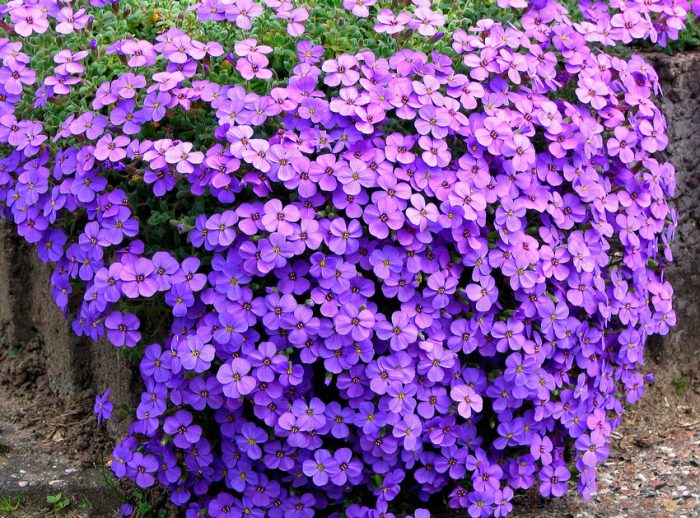
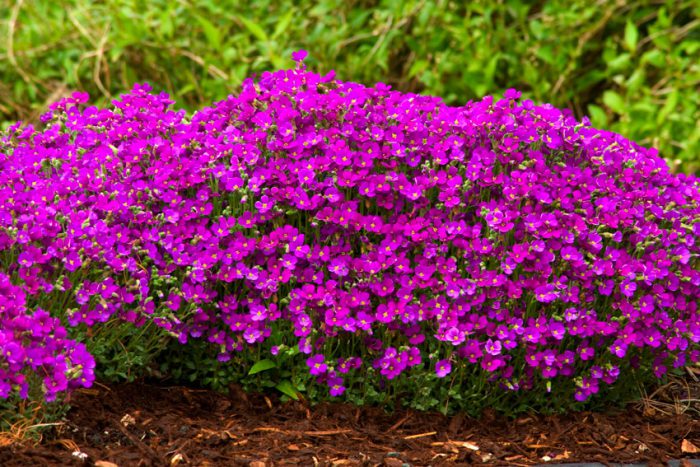


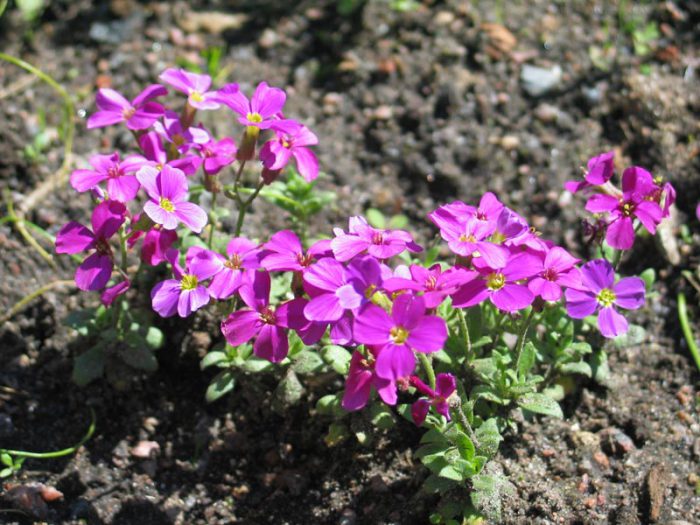


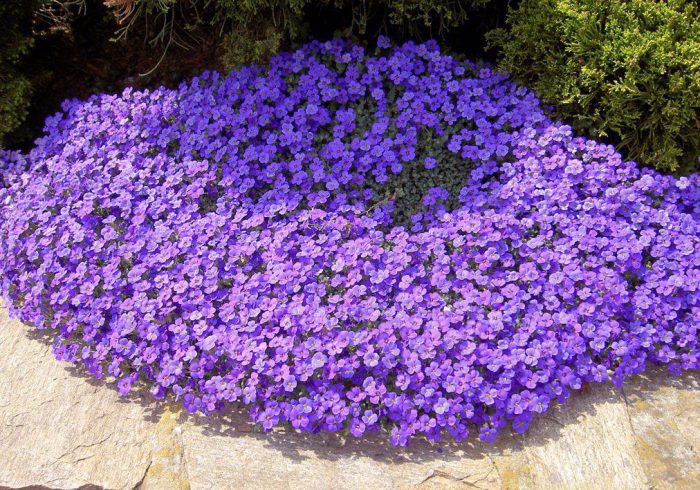
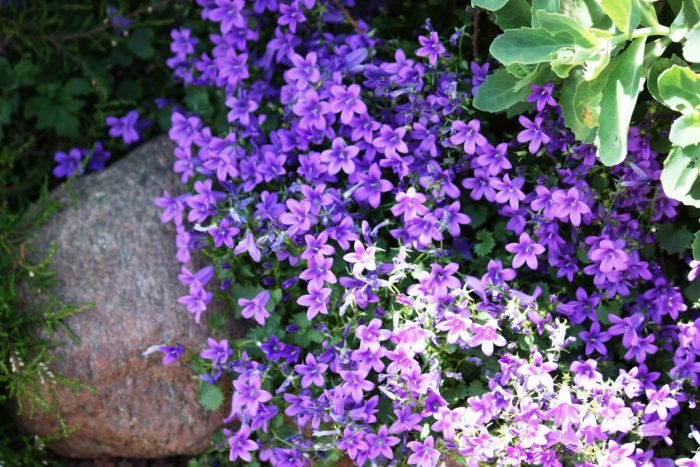

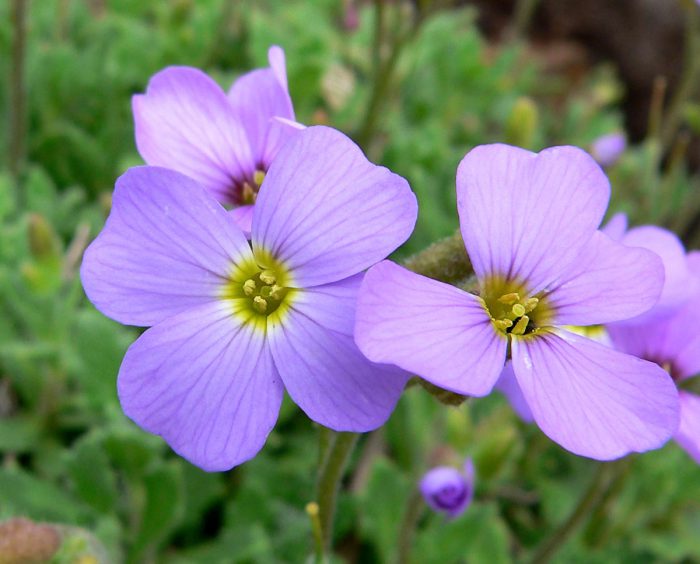










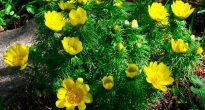

Is it possible to plant Aubrieta on a brlkonnoe koshpo and which variety is more suitable, and what year does it start to bloom?